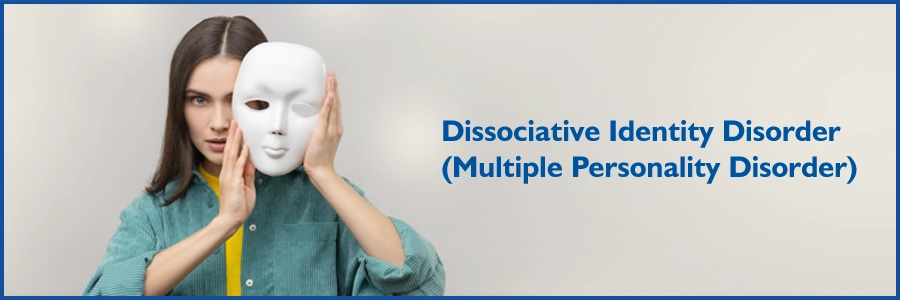
Dissociative Identity Disorder (Multiple Personality Disorder)
Is it possible for one individual to have multiple personalities? Yes, it is! And this is a condition known as Dissociative Identity Disorder (Multiple Personality Disorder).
People suffering from DID may feel emotionally detached from their experiences and even forget to do or say something others witnessed. The memory gaps, confusion, and stress of living with the subjective impression of having "not-me" experiences can be stressful. Let's understand more!
What is dissociative identity disorder?
Dissociative identity disorder, often called multiple personality disorder, is a severe mental condition. Individuals with DID cannot make meaningful connections with their thoughts, feelings, memories, activities, and sense of identity.
Patients with this disease have a primary personality and one or more alternate personalities. The main personality is usually passive, dependent, and depressed. The alternative personalities may differ in age and gender, as well as in their emotions and preferences. When not in charge, these personalities control the patient and are unaware of what is going on in real time. As a result, the patient will have memory gaps.
What are the types of dissociative identity disorder?
One of the dissociative disorders that impact people's ability to connect with reality is dissociative identity disorder. Other dissociative disorders are:
- Depersonalization disorder, also called derealization disorder, is a condition in which patients feel detached from their behaviors.
- Dissociative amnesia is another type of DID disorder in which the patient has difficulty recalling facts about themself.
What are the signs and symptoms of dissociative identity disorder?
People suffering from dissociative identity disorder have two or more different personalities, known as alters. The 'core' identity is the normal personality. Genders, interests, ethnicities, and ways of engaging with their environment may differ among identities. Other common signs and symptoms of this condition include the following:
- Delusions
- Depression
- Disorientation
- Drug or alcohol abuse
- Anxiety
- Suicidal thoughts or self-harm
- Memory loss
What causes dissociative identity disorder (DID)?
DID is usually the result of physical abuse as a child. It can occur due to a natural disaster or another traumatic situation, such as combat. The condition is a way for individuals to distance themselves from or detach from trauma.
How can dissociative identity disorder (DID) be treated?
Some medications may help with DID symptoms like depression or anxiety. However, psychotherapy is the most effective treatment. A healthcare specialist with expertise in mental health problems, such as a psychiatrist can direct anyone to the proper treatment.
The treatment focuses on:
- Identifying and addressing past trauma or abuse
- Managing sudden behavioral changes
- Combining multiple identities into a single identity
Secure your health with a second opinion. Make informed decisions and book your appointment today!
Get A Second OpinionDo you still have any questions about DID? Let's clear all of them!
Can you ever be cured of DID?
No, there is no cure for dissociative identity disorder, and the condition will affect most people for the rest of their lives. However, identifying the signs as early as possible and getting treatment can help patients control symptoms. Parents, caregivers, and teachers should be alert for warning indicators in young children. If treatment begins quickly after an episode of abuse or trauma, DID may be prevented from progressing.
Treatment can also assist in the identification of triggers that cause personality or identity changes. Stress and substance misuse are common triggers. Managing stress and avoiding alcohol can help to lessen the frequency of various behavioral changes.
Can any test diagnose dissociative identity disorder?
There is no diagnostic test for dissociative identity disorder. Doctors may examine the patient's symptoms and personal health history. They can run tests to rule out medical reasons for the symptoms, such as head injuries or brain tumors.
This condition commonly manifests itself in childhood, between the ages of 5 and 10. However, parents, teachers, and doctors may overlook the warning signs. It is sometimes confused with other common behavioral or learning disabilities in children. Attention deficit hyperactivity disorder (ADHD) is one example. As a result, DID is usually not identified until adulthood.
Is it possible to make living with DID easier?
Living with DID can be made better with a strong support system. Determine that healthcare providers, family members, and friends are aware of and understand the situation. Communicate with the support system openly and honestly, and don't be hesitant to ask for help.
At what age do people get DID?
Dissociative identity disorder usually begins between the ages of 5 and 10 years old. It may go unnoticed because it is considered that a child is playing a game in which they pretend to be someone else.
Who is at risk for dissociative identity disorder?
People who have experienced long-term physical and emotional abuse as children are more likely to develop dissociative disorders.
If you notice any changes in your child's behavior, take him or her to the doctor immediately. The doctor can recommend you to a psychiatrist who can assist your child in recovering and developing appropriate coping strategies.
Do you want to meet an expert psychiatrist at Medicover Hospitals? Know about them and schedule your appointment!
https://www.medicoverhospitals.in/doctors/psychiatrist/hyderabad
